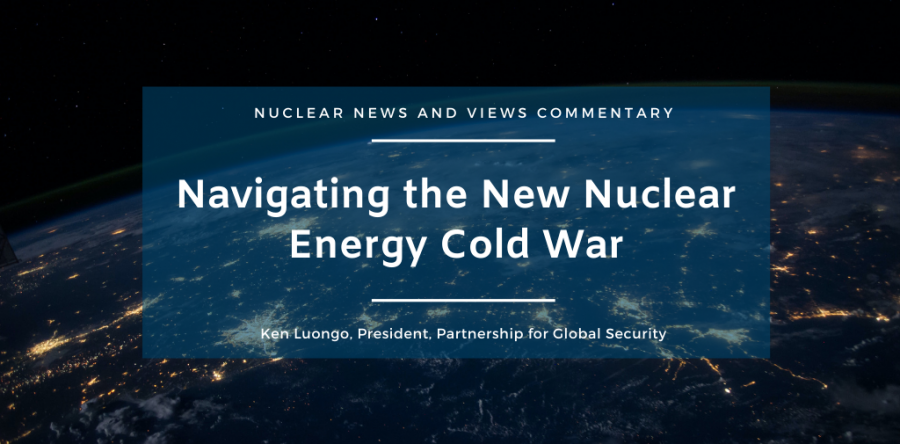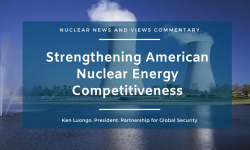The inability of governments to act with alacrity when presented with opportunity is alarming. This is the case with the coming crash of Russia’s control of the international nuclear market. The Russian government will be hobbled in its nuclear export ambitions as a result of its unconscionable invasion of Ukraine. But democratic governments are not well organized to take advantage of this situation, opening a gap for China to exploit.
There are three key components of this opportunity.
First, expanding clean energy. The new report from the Intergovernmental Panel on Climate Change made clear that “immediate and deep emissions reductions across all sectors” is necessary. This requires increased clean energy including expanding the role of nuclear energy as the century progresses.
The ambitions for nuclear energy began to accelerate before the Russian invasion but now have intensified with zero-carbon and energy security the driving rationales.
For example, the U.K. recently decided that it wants 25% of its total electricity output to come from nuclear power. It currently is about 16% of the total. This would require building 8 new, large power stations. One is already under construction at Hinkley Point. Several Eastern European nations are moving toward nuclear energy to replace coal and eliminate dependency on Russia’s fossil fuels. There also is an emerging market for smaller reactors in several regions.
Second, stifling Russia’s energy export income. Countries in Europe that are dependent on Russian fossil fuels are racing to retreat and trying to find replacements for that coal, oil, and gas. This easier for smaller countries and more difficult for major industrial nations. But as increasing evidence of the savagery of Russia’s invasion surfaces, European Union nations are recoiling at the $20 billion they have paid Russia for energy since the war began.
This financing constriction extends to Russia’s income from nuclear exports. The blowback damage on the Russian nuclear energy sector from its invasion already is clear. It will delay the plants its state-owned nuclear company, Rosatom, is building in Turkey and likely has killed its joint project with Finland. It also may find it difficult to proceed apace with reactors in Bangladesh and Egypt, and perhaps India.
Third, the emergence of a democracy-dictator divide. The COVID pandemic and the Russian invasion have begun to separate the world into democratic and authoritarian spheres. No one wants to formally declare it a new cold war, but the close economic interdependence that once dominated global trade is unlikely to survive in its current form. Democratic nations already are retreating from their dependence on Russian and Chinese supply lines.
In the civil nuclear area, this will require that alternative technology sources and arrangements be created. This is particularly important because Russia is central to the provision of the uranium fuel for existing plants around the globe and manufacturing the HALEU fuel needed to run next-generation reactors. Russia also has critical test facilities for reactor components that other nations don’t possess.
As Russia’s export power declines, it is essential that it not be replaced by China, which largely has sided with Russia on the invasion and opposed an international resolution that condemned Russia’s violation of nuclear norms in Ukraine. China’s indigenously designed large reactor, the Hualong I, has been approved by British regulators. This makes it an ideal candidate for wider export. It already is operating in Pakistan. And Argentina recently contracted for one of these reactors. China also is developing next-generation technologies.
But democratic governments are in disarray on how to prevent China from replacing Russia.
Canada is a one example. It has been supportive of nuclear power as a response to climate change and it has a thriving small and advanced reactor program. But the government’s new Green Bond Framework, intended to mobilize over $4 billion in support of climate objectives, excludes nuclear investments. This is a blow to both carbon reduction and nuclear geopolitics.
It also puts Canada out of synch with the European Union, the U.S., and increasingly Japan and South Korea. The EU’s green finance taxonomy includes nuclear power. Japan and South Korea quickly are moving away from their post-Fukushima nuclear energy-skepticism as they pursue zero-carbon commitments and energy security.
The U.S. government is providing billions in support for existing and future nuclear plants. With that investment it should be providing leadership and developing strategy to seize the nuclear export offensive. But it’s not. And it’s unclear who in the government should or could formulate this plan or if it’s even a priority consideration.
This is in contrast to the seriousness displayed by the U.K. The British Prime Minister gathered the leaders of the nation’s nuclear industry to discuss ways to “rapidly accelerate nuclear projects in the U.K” in advance of its commitment to new plants.
This type of meeting is needed in the U.S. but hasn’t been convened, and perhaps not even contemplated. It also needs to be extended multilaterally. A high-level government-industry gathering of democratic nation nuclear suppliers is needed.
The agenda for this gathering is clear. Ensure that Russia cannot resurrect its nuclear export dominance. Prevent China for replacing Russia. Identify mechanisms for democratic governments and companies to collaborate to build the large reactors nations want, while sharing supply chains and profits. Develop a strategy for controlling the emerging small reactor market. And maintain and improve high levels of nuclear governance and global security.
The U.S. and its allies have been waiting for an opportunity to depose Russia as the global nuclear export leader. The opportunity and agenda is now before them. The time to act is now.
Ken Luongo, President, Partnership for Global Security




